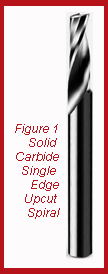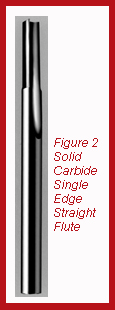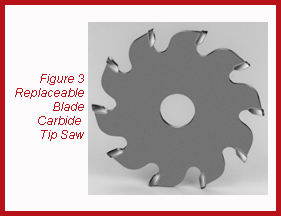|
ROUTING: Real World Routing Solutions
This article is the second in
a four-part series designed to
address common routing problems.
To read Part 1 of this series go to
www.plasticsmag.com and click on
“Routing” under the Series tab.
Cutting tool technology has
evolved dramatically since
the 1980s, when dedicated
router tooling began to take shape.
This, in turn, has enabled primary
and secondary fabricators in the
plastics’ industry to move from
generic tooling to material-specific
cutting tools.
However, there continues to be a lot of confusion
regarding optimal machining methods and practices. In
the last issue, we looked at three real-life applications in
which fabricating problems and their cutting tool solutions
were given. This month, three additional scenarios
are presented.
Scenario 4
Material Cut: ABS and extruded
acrylic
Product: Covers for surveillance cameras
Router Type: 5-axis CNC
Feeds & Speeds: 18,000 rpm at 100
ipm
Initial Tooling: Straight flute generic
plastic tooling
Problem: Initial call was placed
because of consistency problems with
current carbide tipped tools.
This scenario is very typical of what
happens in many manufacturing and
fabrication shops: Tooling users
become comfortable with a particular
tool and do not continue to look for
newly developed or advanced tooling
that can increase production and bottom
line profits. After an on-site visit
with this fabricator and some experimentation,
 a new tool was found that
allowed significantly increased feed
rates and, at the same time, exhibited
increased finish quality cutter life.
a new tool was found that
allowed significantly increased feed
rates and, at the same time, exhibited
increased finish quality cutter life.
Using a standard spiral “O” flute
with geometry modified to allow it to
cut both ABS and soft acrylic, the
fabricator was able to increase feed
rates from 100 ipm to 250 ipm
(decreasing part production cycle
times and cost) and was also able to
drop spindle speeds from 18,000
rpm to 16,000 rpm (increasing cutter
life). This was all accomplished
with an improved surface finish on the final part and using
1/4-inch diameter and smaller tooling (Figure 1).
A second problem brought to light in this scenario was
the desire by the fabricator to use a single tooling style
(with various diameters) to handle machining of multiple
types of plastic. Normally, this goes against the trend of
tooling suppliers who are developing
advanced tooling that is very
application-specific. As feed rates
increase and surface finishes
become more and more important,
there will be a significant decrease in the availability
of “generic” plastic tooling.
New tooling is designed for specific applications
and it is extremely difficult to find an optimum cutter
geometry when multiple materials being cut
require different machining parameters. This fabricator
was lucky, but this scenario is going to become
the exception, rather than the rule, as feed rates
and CNC router technology continue to advance.
Scenario 5
Material Cut: Lexan
Product: Fabricated parts for the electrical industry
Router Type: Newly purchased 3-axis router
Feeds & Speeds: 2,500 rpm at 25 ipm
Initial Tooling: Plastic end mill
Problem: The new (and expensive) CNC router was not
paying for itself.
As manufacturers leave the metal-working industry and
move into the primary and secondary plastics fabrication
market, these problems will occur. CNC mills are designed
to machine metals: they are very efficient at it. But 15
years ago or more, their use in the plastics industry began
to skyrocket. They were able to make intricate, multi-axis
cuts on a large variety of soft and hard plastics and were
typically much more efficient and effective than other
methods available for producing complex finished parts.
In those days, CNC routers were not readily available
and those that
 existed did not have the multi-axis capabilities
and/or rigidity required for complex parts and
acceptable surface finishes. With current router technology,
feed rates are five to ten times faster than CNC mills
and these feed rates are parameters to be realized, however,
proper tooling must be used.
existed did not have the multi-axis capabilities
and/or rigidity required for complex parts and
acceptable surface finishes. With current router technology,
feed rates are five to ten times faster than CNC mills
and these feed rates are parameters to be realized, however,
proper tooling must be used.
End mills are designed to run at end mill speeds
(up to 8,000 rpm and 50 ipm) and do not complement
a CNC router that is capable of spindle
speeds beginning at 10,000 rpm and approaching
30,000 rpm with 500 ipm feed rates or higher. It
is impossible to justify the cost and return-oninvestment
for a machine in which costs can
exceed several hundred thousand dollars when run
at CNC milling feeds and speeds.
By convincing the fabricator (and the machine operator) that router tooling was designed to perform
best at high spindle speeds and feed rates,
the cutting tool company was able
to show the increased chip extraction
available as well as the subsequent
productivity and the surface
finish improvement (Figure 2).
The end result was the use of a 1/4-inch diameter
dedicated plastic straight “O” flute with speed rates at
150 ipm and spindle speeds at 16,000 rpm. The fabricator
achieved an increase of six time greater throughput
with a better surface finish.
Scenario 6
Material Cut: Acrylic and ABS
Product: Vacuum formed parts of various configurations
Router Type: 3-axis CNC
Feeds & Speeds: 18,000 rpm and 90 ipm
Initial Tooling: 3-wing slotting cutter with arbor
Problem: Part damage and programming concerns
This scenario is similar to the first in that the fabricator
was unaware of new dedicated plastic tooling that
was designed to be an “instant fix” to his problem.

The fabricator was using a slotting cutter designed for
wood to remove flash from a variety
of formed parts. The
geometry of the slotting
cutter, as well as the large
retaining nut at the bottom,
were causing numerous
problems such
as material melting,
scarring and occasional
damage when the programmer
failed to check for
adequate clearance between
the retaining nut and the
material.
The solution was to use dedicated
plastic saws designed
specifically to run on a CNC router through the use of an
arbor (Figure 3). Tooling such as this is being constantly
designed and marketed to prevent plastics manufacturers
and fabricators from having to “make-do” with tooling that
was designed for another industry or application.
By increasing the tooth count to 10 or 20 teeth (ABS
and acrylic respectively) on a 4 1/2-inch arbor mounted
saw, the fabricator increased feed rates to 150 ipm and
eliminated virtually all post-cutting inspection and
rework operations.
The preceding three scenarios all illustrate two
important facts about router tooling: -
Router tooling is designed for very specific applications
and must be chosen and run accordingly.
- There is continuing advancement in the router tooling
industry - just as there is in the machine industry -
and plastic manufacturers and fabricators must constantly
scan the marketplace for application specific tooling
to solve their problems or increase their productivity.
For more information, click on the author biography at the top of this page.
|